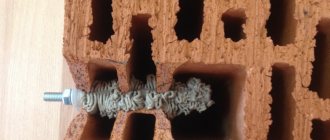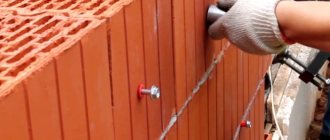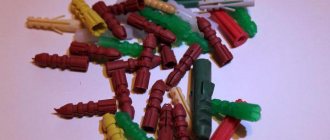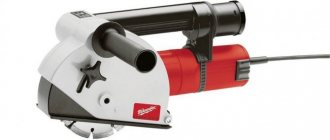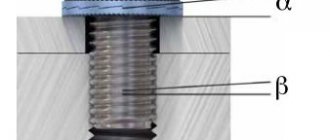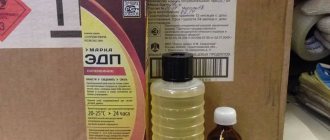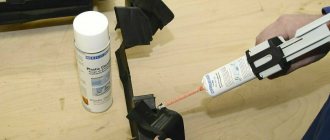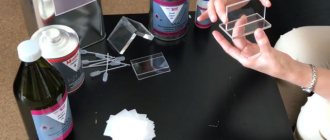During construction work, it becomes necessary to mechanically connect structural elements. Builders and installers do this using dowels made of plastic or metal. Hardware is used with solid stone, brick, and concrete bases. An alternative is chemical anchors. Therefore, builders opt for Hilti glue for anchors, which is produced in Liechtenstein. Products are produced in the form of capsules and injections.
Installation of reinforcement outlets using Hilti chemical anchors
The production of Hilti adhesive anchors is based on epoxy resin and urethane methacrylate. These products are used for fastening mounting and working fittings. The adhesive anchor is selected according to calculations taking into account the following factors:
- load level on the reinforcing bar;
- base temperature;
- depth, diameter and other dimensional characteristics of the embedment.
The technology of reinforcement outlets using Hilti anchors is used in Europe and the Russian Federation. Hilti chemical anchor products can be used to solve various construction and installation problems.
Chemical capsule anchors "Hilti"
This type of Hilti glue for anchors is presented in the form of a capsule. Each capsule is designed for mounting one fastener element. The capsules themselves are represented by cylindrical containers filled with glue. This is a two-component composition, the mixing of which is carried out during installation.
Such products are marked HVU, which indicates:
- depth of permissible mounting hole;
- thread of the anchor stud.
For example, if a product is marked HVU M14X100, then this indicates a hole depth of 100 mm in the base and an anchor pin with M14 thread.
The Liechtenstein company produces chemical anchors for a wide range of threads: from M8 to M39.
The process of installing a stud using such a capsule is approximately as follows:
- First, a hole of the required diameter and depth is drilled in the base. The manufacturing company advises choosing a drill diameter 2-3 mm larger for studs with threads from M8 to M16, and 3-4 mm larger for studs with threads from M20 to M39.
- Then the drilled hole must be cleaned of dust using compressed air or any mechanical method.
- Next, you need to insert the Hilti chemical capsule into the hole.
- After this, you need to screw the pin clockwise into the hole (it will damage the capsule, due to which the components will mix and the solution will begin to harden).
At positive ambient temperatures, the solution will completely harden in about 20-60 minutes. At temperatures around zero or below, it will take several hours to harden. To install metal products that experience severe dynamic loads during operation, it is recommended to use special HVU-TZ capsules.
Installation technology
The installation process of anchors depends on the type of fastening element.
Installation of chemical anchors
Installation of injection anchors, unlike capsule anchors, is carried out with special equipment - a dispenser.
Chemical anchor installation device
In general, the installation diagram looks like this:
- a hole is drilled in the selected location with parameters that fully correspond to the fastening element;
- If possible, dust and other accumulations of dirt are completely removed from the hole (you can use a syringe or other similar devices);
- a capsule is inserted into the hole (installation of capsule anchors) or the hole is filled with an injection anchor using a dispenser;
- the fastening element is inserted to the desired height;
- wait the time (according to the attached instructions) necessary for the adhesive mixture to dry completely.
Chemical anchor installation technology
An overview of chemical anchors and the method of their installation are presented in the video.
Installation of expansion and drive-in anchors
Installation of drive-in and expansion anchors is performed as follows:
- a hole is drilled, the width and depth of which corresponds to the diameter and length, respectively, of the fastening element;
- dust and dirt are removed from the hole (this operation can be neglected, since in this situation it is not significant and is performed only for cleanliness);
- a fastening element is inserted into the prepared hole: the driving anchor is driven into the hole with a hammer, and the spacer anchor is screwed in with a key (screwdriver depending on the type) of the appropriate size.
Hilti injection anchor systems
Such chemical anchors are marked HIT and are presented in a plastic cartridge with foil containers (one contains glue, the other contains a hardener composition). The Liechtenstein manufacturer Hilti offers a choice of seven types of such anchors. This type of Hilti glue for anchors differs in the following characteristics:
- scope of use;
- glue component and hardener type;
- cartridge volume (330 ml or 500 ml);
- permissible load on the stud.
A striking example of the company’s products from Liechtenstein is HIT-MM-Plus glue, which is the most popular and inexpensive (a 330 ml container costs about 700-1000 rubles). Two-component adhesive made from urethane methacrylate.
The manufacturer recommends using it for mounting studs, the thread of which varies from M6 to M16. Installation is carried out in the following types of bases:
- brick;
- concrete;
- block;
- stone (artificial and natural stone).
The most expensive type of product is HIT-RE-500-V3 glue, the cost of which is about 3,000 rubles. It is used for installation of releases of load-bearing reinforcement elements of floors, foundations, stairs, columns. The glue is made on the basis of epoxy resin with additives, due to which it is capable of holding reinforcement with a diameter of 10 to 55 mm.
Types of anchors and their features
Currently, Hilti produces several types of anchors:
- chemical;
- spacer;
- driving.
Chemical anchors
A chemical anchor is a special dowel that is equipped with an adhesive composition for fixation in materials such as:
- hollow brick;
- expanded clay concrete;
- shell rock;
- limestone and so on.
Thanks to its features, the attachment to porous substrates is highly durable and extremely reliable. However, replacing such a fastening element, if necessary, will be quite difficult, since the base will have to be somewhat destroyed.
Currently, chemical anchors are produced in two types:
- Chemical capsules (marked HVU). The devices are a container (most often made of polyethylene) of a certain size, inside of which there is a two-component adhesive composition. Upon contact with a metal dowel, the container depressurizes and, under the influence of air, mixes and hardens, thereby fixing the fastening element. The main advantages of this type are the speed and ease of installation. Negative qualities include the relatively high cost and dosage of the adhesive composition, which does not allow achieving strong fixation of the anchor when installed in large-volume voids.
Capsule chemical anchor
Only one fastening element can be secured using the anchor capsule.
- Chemical injections (marked HIT) are two-capacity ampoules, one of which contains the adhesive composition, and the other contains the hardener. Unlike capsules, injection dowels can be produced in different volumes, which facilitates reliable fastening even in voids. Another advantage of this type is the lower cost, justified by the use of glue of a different composition. A significant disadvantage of the injection anchor is the need to purchase (rent) additional equipment for installation.
Injection Type Chemical Anchor
With the help of injection anchors, several fastening elements can be secured simultaneously.
Expansion anchors
Unlike a chemical anchor, an expansion anchor is a more standard fastening element. As the threaded rod is tightened, the spacer part of the anchor increases along its entire length, which allows you to create strong fastenings even for massive structures.
Standard anchor for fastening heavy structures
Depending on the type of base to which additional elements need to be attached, the following types of anchors are distinguished:
- for concrete with cracks – HST/HST3. this type can also be used for installation in areas with seismic activity;
- for solid bases - HSA or HSV (a more budget option, also highly durable);
- for fastening heavy structures - HSL 3 or 3G.
Unlike chemical fasteners, expansion anchors can be replaced without destroying part of the base.
Drive-in anchors
The last type - drive-in anchors are easy to install. Such fasteners are intended for fixing sheathing (plasterboard, wall panels, etc.), insulating materials or light loads (light weight structures).
They can be made:
- made of metal. They are more durable, but at the same time more expensive;
Drive-in anchor made of metal
- made of plastic. Designed for fastening lightweight structures.
Drive-in anchors made of plastic
Adhesive anchor Hilti HIT-RE-100
This type of Hilti glue for anchors is made on the basis of epoxy resin and hardener, and is two-component (the components are mixed during installation).
Using these products, the following construction and installation work is performed:
- installation of additional metal structural parts;
- installation of load-bearing metal structures (beam, column and other types);
- replacing incorrectly installed reinforcing bars or installing missing reinforcement;
- installation and connection of concrete reinforcement bars.
The Hilti anchor HIT-RE-100 has a wide operating temperature range: from -40 to +70° C. These products can be stored and transported at temperatures from +5 to +25° C. Tools for its installation are: HDM, HDE 500-A22.
Advantages of the Hilti HIT-RE-100 adhesive anchor
When using HIT-RE-100 adhesive for anchors in concrete, consumers can count on the following advantages of this product:
- Possibility of use indoors and outdoors with the base material, regardless of its current state (dried, moistened, filled with moisture, etc.).
- Large selection of additional accessories (metal brushes, electric dispenser, injection pistons).
- High level of efficiency for use in solid concrete foundations without cracks.
- Long curing period, due to which you can make the necessary adjustments during installation.
- Easy to clean, making installation much easier.
The cost of adhesive for anchors in concrete Hilti HIT-RE-100 starts from 1,500 rubles for a 330 ml container.
What are they needed for?
With the help of such devices, working with heavy materials becomes much easier.
Chemical fastening systems are necessary for working with heavy and difficult-to-drill materials and in difficult-to-reach locations. Steel dowels are needed to further strengthen the building structure. Used together. Their goal is to make installation convenient for the person who will perform it. Help reduce time spent on construction and minimize effort.

